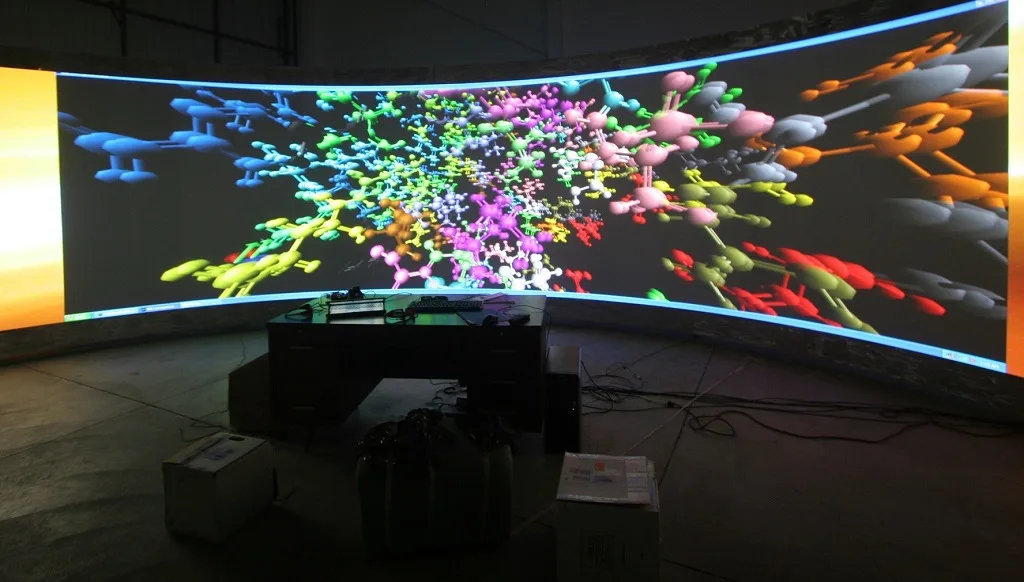Curved Display Technology: Revolutionizing Visual Experiences

Curved display technology has rapidly emerged as a groundbreaking advancement in the world of visual displays. The concept of bending a traditionally flat screen into a curved form has intrigued both tech enthusiasts and industry professionals alike. This article delves into the history, development, applications, and current implementations of curved display technology, providing a comprehensive overview of its impact and future potential.
What is Curved Display Technology and When Did It Appear?
The inception of curved display technology can be traced back to the early 2000s when researchers and developers began experimenting with flexible display materials. The primary goal was to enhance the viewer’s experience by creating more immersive and engaging visual displays. By 2013, the first commercially available curved OLED (Organic Light Emitting Diode) televisions were introduced by major manufacturers such as Samsung and LG. These initial models showcased the potential of curved displays to provide a wider field of view and reduce glare, setting the stage for further advancements in this technology.
Since their debut, curved displays have evolved significantly. The development of more flexible and durable materials has allowed for greater curvature and improved image quality. These advancements have not only enhanced the visual appeal of curved screens but have also made them more accessible and practical for a variety of applications. Today, curved displays are utilized in everything from televisions and monitors to smartphones and wearable devices, demonstrating their versatility and growing popularity in the consumer market.
How Does This Technology Work?
Curved display technology relies on flexible substrates and advanced manufacturing techniques to bend the screen into a curved form without compromising its functionality. The most commonly used material for these displays is OLED, which offers superior flexibility compared to traditional LCD (Liquid Crystal Display) screens. OLED panels are composed of organic compounds that emit light when an electric current is applied, allowing them to be easily manipulated into various shapes while maintaining high resolution and vibrant colors.
One of the key benefits of curved displays is their ability to enhance the viewing experience by providing a more natural field of vision. The curvature of the screen helps to reduce distortion and glare, creating a more comfortable and immersive viewing environment. Additionally, curved displays can improve contrast and depth perception, making images appear more lifelike and three-dimensional. This technology also allows for thinner and lighter screens, making it ideal for portable devices and applications where space is limited.
Where Can Curved Displays Be Used?
Curved display technology has found applications in various sectors, including consumer electronics, automotive, and healthcare. In consumer electronics, curved televisions and monitors are becoming increasingly popular due to their ability to provide a more immersive viewing experience. These displays are particularly well-suited for gaming and home theater setups, where the enhanced field of view and reduced glare can significantly improve the overall experience.
In the automotive industry, curved displays are being integrated into dashboard and infotainment systems to provide drivers with a more intuitive and aesthetically pleasing interface. These displays can be customized to fit the contours of the vehicle’s interior, offering a seamless and visually appealing design. Additionally, curved displays can be used in head-up displays (HUDs) to project important information directly onto the windshield, improving safety and convenience for drivers.
The healthcare sector is also exploring the use of curved displays for medical imaging and diagnostic equipment. The enhanced contrast and depth perception provided by curved screens can help medical professionals interpret complex images more accurately. Curved displays can be used in surgical monitors, MRI machines, and other diagnostic tools to provide clearer and more detailed visuals, ultimately improving patient outcomes.
Where is This Technology Already Used?
Curved display technology is already being widely adopted across various industries and applications. In the consumer electronics market, curved televisions and monitors are becoming mainstream products, with major brands like Samsung, LG, and Sony offering a range of models to cater to different preferences and budgets. These displays are praised for their superior image quality and immersive viewing experience, making them a popular choice among consumers.
In the automotive industry, companies such as Tesla and Mercedes-Benz have incorporated curved displays into their vehicle interiors, providing drivers with a more advanced and visually appealing interface. These displays are used for navigation, entertainment, and vehicle control systems, enhancing the overall driving experience.
Curved displays are also making their way into public spaces and commercial settings. Digital signage and advertising displays often utilize curved screens to attract attention and provide a more engaging visual experience. In retail environments, curved displays can be used to create dynamic and eye-catching product showcases, helping to draw in customers and increase sales.
Moreover, the use of curved displays in virtual and augmented reality applications is growing. The immersive nature of curved screens makes them ideal for VR headsets and AR glasses, where a seamless and encompassing visual experience is crucial. These applications highlight the versatility and broad appeal of curved display technology in both consumer and professional markets.

Future Prospects of Curved Display Technology
As technology continues to advance, the future prospects for curved displays look promising. Research and development efforts are focused on creating even more flexible and durable materials that can withstand greater curvature and provide higher resolution images. These advancements will likely lead to the development of new and innovative applications for curved displays, further expanding their reach and impact.
One of the most exciting potential applications for curved displays is in the realm of wearable technology. Flexible and lightweight curved screens could be integrated into smartwatches, fitness trackers, and other wearable devices to provide a more comfortable and ergonomic user experience. Additionally, curved displays could be used in foldable smartphones and tablets, offering a larger screen area in a more compact form factor.
The integration of curved displays with other emerging technologies, such as artificial intelligence and the Internet of Things (IoT), also holds great promise. These displays could be used to create smart home devices with more intuitive and interactive interfaces, or to develop advanced medical equipment that provides real-time data and diagnostics. The possibilities are endless, and the continued evolution of curved display technology will undoubtedly lead to new and exciting innovations.
How Effective is Curved Display Technology?
The effectiveness of curved display technology can be measured in terms of its ability to enhance the viewing experience and provide practical benefits across various applications. Studies have shown that curved screens can reduce eye strain and provide a more comfortable viewing experience compared to flat screens. This is due to the natural curvature of the human eye, which allows for a more immersive and less distorted visual experience when viewing a curved display.
Additionally, curved displays have been found to improve contrast and color accuracy, making images appear more vivid and lifelike. This is particularly beneficial in applications such as gaming, where high-quality visuals are essential for an immersive experience. The reduced glare and reflections offered by curved screens also contribute to their effectiveness, making them suitable for use in a variety of lighting conditions.
Overall, curved display technology has proven to be a valuable innovation that enhances the visual experience and offers practical benefits across a range of applications. As the technology continues to evolve and improve, it is likely that curved displays will become even more prevalent and impactful in the years to come.






